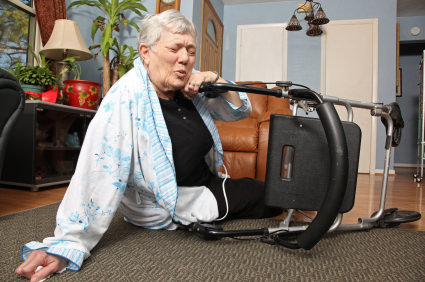It’s a fact: according to the Center for Disease Control, each year three million senior citizens accidentally fall in what is becoming an epidemic that could be largely preventable. Falls are the most common cause of traumatic brain injuries (TBIs.) and falling once doubles the chances of falling again.
In addition, the average fall can cost victims today as many as 8 weeks in the hospital and over $35,000 in avoidable medical expenses just for single occurrence.
From 2007 to 2016, the fall death rate in the U.S. increased by a whopping 30%. If trends continue, the CDC predicts that by 2030, seven fall deaths will take place among elderly people EVERY HOUR.
Today, nearly 90% of seniors report they want to “Age-In-Place” with dignity as long as possible. Unfortunately, many seniors don’t take proper precautions to make their living environment as safe as it could be to achieve that objective.
As a former traveling nurse and health-and-wellness coach with expertise in fall prevention, I’ve seen too many tragic injuries that could have just as easily been prevented. I’ve discovered some simple solutions through the years that you can easily implement around your home that will help you to Age-in-Place with dignity for much longer. By making the following simple adjustments to your surroundings, you’ll quickly see just how easy it is to improve your at-home safety and enjoy a much safer, healthier, and happier environment.
To start, be sure to improve the lighting in every room in your home. Depending on the size of each room, make sure to use at least 150-watt bulbs in each location. Your electric bill may cost a wee bit more but making this simple change can allow seniors to see everything far more easily, far more clearly, and far more quickly to prevent devastating injuries and falls.
Also, when living in a single-story home or when modifying your home, it’s important to ensure that all items, fixtures and features that you most often use are situated as close by as possible and on the same level. This will go a long way toward helping you to accomplish the vast majority of your most common tasks each day. It will also assist you with avoiding having to go up and down stairs more often than necessary that can increase instability and potentially lead to greater numbers of falls.
In addition, here are seven key areas in the home in which you can make some simple additional improvements to help you to age-in-place with dignity longer:
Bathroom
Getting into the bathroom can itself be a challenge for many seniors, so be sure to remove all floor clutter so you’ll have enough space to move around, especially if you’re using a cane or walker. Getting on-and-off the toilet can be another challenge for many seniors, so getting a raised toilet seat or grab bars that can make navigating the bathroom much easier is a wise choice. By adding grab bars to the walls, this will further help give each person using them the additional support needed to more easily get around. Lastly, if you’re able to add a swinging door to your tub or shower it will make it easier for you or your loved one to get in-and-out of when in use.
Bedroom
As with your bathroom, be sure to remove all floor clutter and cords from your room to eliminate obvious hazards that can cause you to trip and fall. Make sure your doorways are at least 32” wide so if you need to use a wheelchair you will have plenty of room to get in-and-out of the room. Lastly, if your bed sits too high to get into easily, get a bed step that is sturdy and has a support rail or simply replace your bed with one that has shorter legs and sits lower to the ground (My company created the revolutionary step2bed to more precisely address this very need in the market!)
Kitchen
Review what appliances you frequently use like your stove and fridge and make sure you are still able to access them just as easily as the day you first moved in. You will also need to review your cabinets and sinks to make sure you can reach each easily and well. You may need to rearrange those supplies you use most often onto the lowest shelves. If you use a wheelchair, be sure to put your most frequently used dishes, drinking glasses, pots and pans in wheelchair level lower cabinets to ensure against trying to extend beyond your normal range of motion.
Laundry Room
Review the room layout and make sure you’ve removed all clutter to allow you to more easily get around, particularly if you use a walker or wheelchair. Cabinets, counters and shelves should also all be easily reachable. Review what kind of flooring you have and make sure it contains a non-slip coating and is level. Replace this coating at recommended regularly scheduled intervals.
Common Areas
Make sure the width of all doorways are modified to at least 32” so you can get around if you use a wheelchair. Examine all carpet and flooring to make sure there are no loose or raised spots, especially in key transitional areas that can create subtle and frequently unseen fall hazards. Also be sure to remove all rugs and make sure all stairways have a railing or grab bar at comfortable level that you can easily use to help reduce the risk of fall injuries.
Garage & Carport
Make sure you have ample space to get around and make sure to remove all ground clutter that could cause a fall. Also ensure that the storage systems you have can be adjusted for height to your level and further invest in some basic telescopic “grab tools” you can use to more easily access everything you need that cannot be adjusted for height. Install an easy to use automatic garage door if you don’t already have one to make coming and going easier. Lastly, examine all flooring to make sure it is some kind of non-slip coating and be sure to replace it when scheduled maintenance comes due.
Home Exterior
Review the main door you enter and exit through to make sure you can easily move in-and-out. You may need to add a safety ramp if using a walker or wheelchair and you will want to make sure it also has a non-slip coating. Your steps and sidewalks should also be cleared to reduce the risk of tripping and should be checked in advance of using them each day for new branches, ice, snow or other debris that can quickly accumulate overnight.
Bonus Tip!
Finally, make a sketch of each room with their dimensions filled in wherever permissible and keep this sketch along with a flashlight in a handy drawer in your nightstand. That way, in case of a power blackout, you can still manage to get up and about to accomplish what you need without stumbling through the dark and causing a fall.
By making these simple changes today, you can help reduce the risk of falls in the home for you or your loved ones tomorrow.


























